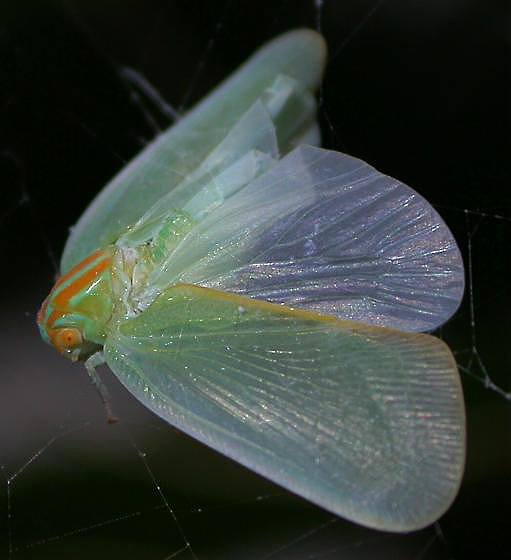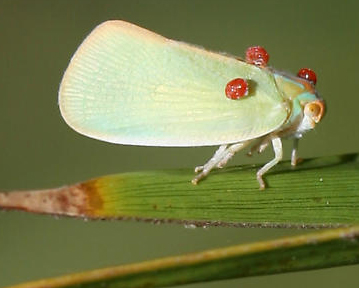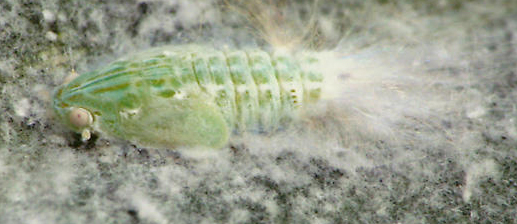Flatid Planthopper
|
adult; Photo © Mike Deep, 2008 |
|
adult with forwings and hindwings exposed; Photo © Jeff Hollenbeck, 2007 |
|
adult with mites; Photo © JN Dell, 2008 |
|
nymph; Photo © Sean McCann, 2006 |
Scientific name
Ormenaria rufifascia (Walker)
Family
Flatidae (Suborder Auchenorrhyncha, Superfamily Fulgoroidea)
Description
Adult: Length about 11 mm; laterally flattened and deltoid in shape; base color is light blue-green with various orange to reddish markings; forewings tent-like in repose, have an orange-yellow border, are triangular in shape, are longer than hindwings; forewings and hindwings membranous; antenna arising on sides of head beneath eyes, separated from front of head by vertical carinacarina:
a ridge or keel
; eyes are orange.
Nymph: Light green with faint longitudinal orange stripes; coloration can be masked by a flocculent wax coating; nymphs drag waxy caudal filaments behind them as they move across the leaf surface.
Diagnostic features
Ormenaria rufifascia adults are rather large for planthoppers, about 11 mm in length. Adults are laterally flattened, deltoid in shape, and appear as tiny colorful sailboats on the lower surface of older palm leaves. Forewings are triangular and are bordered with orange-yellow. The compound eyes are orange.
Distribution
Ormenaria rufifascia has been reported from Florida and Georgia. It is likely to be present throughout the range of Sabal palmetto (cabbage palm) from Louisiana to the Carolinas. It has been reported in Cuba, and intercepted in California on palms shipped from Florida.
Hosts
Palms: Palmatepalmate:
fan-leaved
palm species seem to be the preferred hosts of Ormenaria rufifascia. It has been reported on fan-leaved species within the genera Sabal, Serenoa, Livistona, Washingtonia, Pritchardia, Acoelorraphe, Colpothrinax, Copernicia, and Latania. The natural hosts in Florida appear to be Sabal palmetto (cabbage palm) and Serenoa repens (saw palmetto). The pest has also been reported from the pinnatepinnate:
feather-leaved
species Phoenix canariensis (Canary Island date palm).
Other: Although unconfirmed, records seem to indicate that it has been reported on croton, roses, orchids, and figs.
May be confused with
There are no other species of similar appearance known to occur on palms in the United States and very few species of Flatidae occur on palms anywhere in the world.
Additional comments
Ormenaria rufifascia is not considered a serious pest, although large populations can cause aesthetic damage due to the large amount of honeydewhoneydew:
the sticky, sweet secretion produced by sap-feeding bugs
that supports extensive coatings of sooty mold on the host plants.






